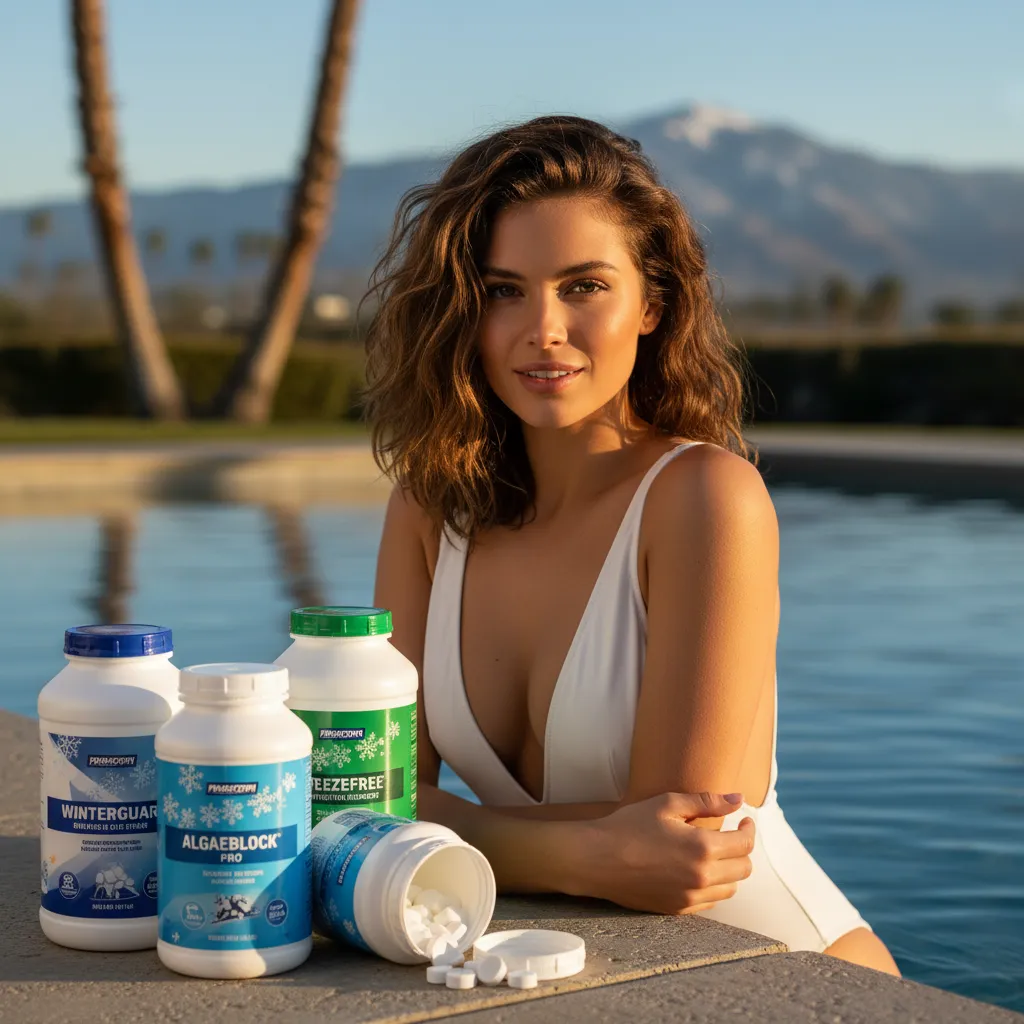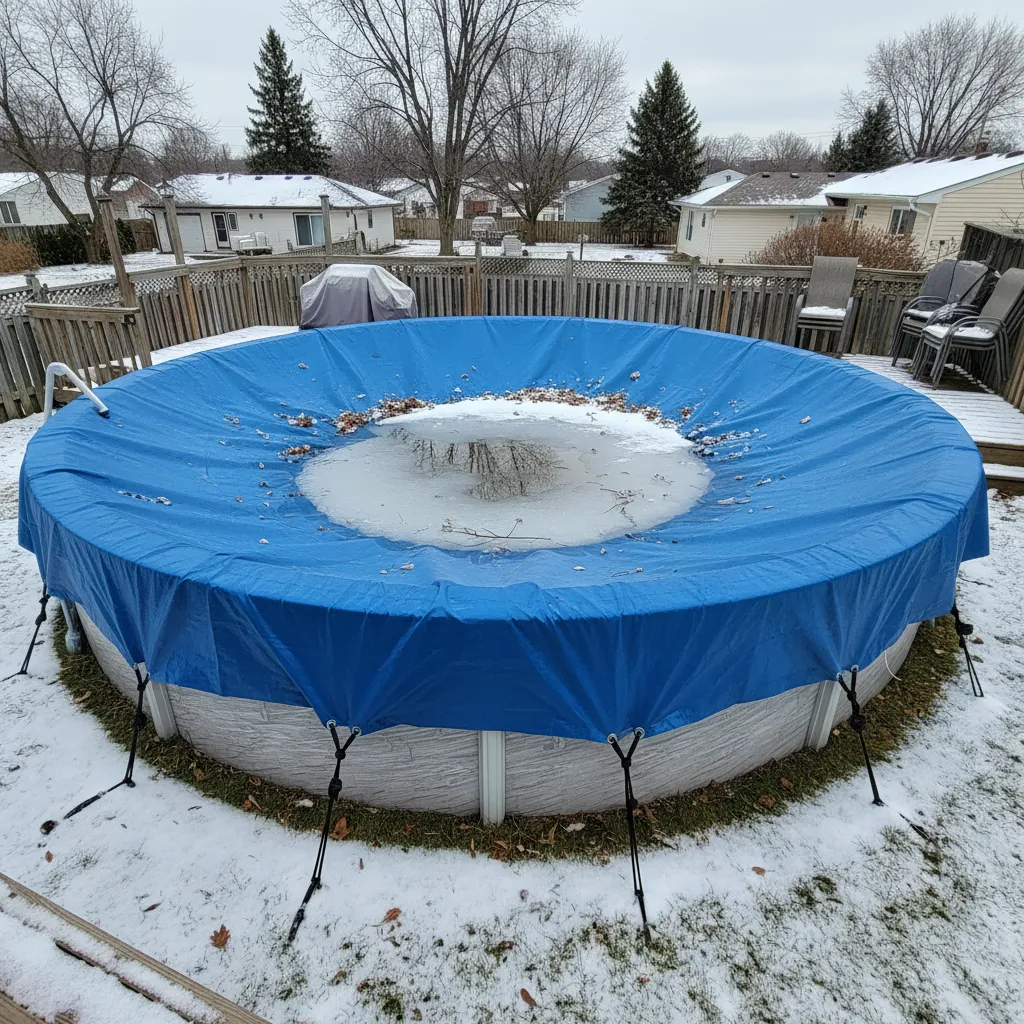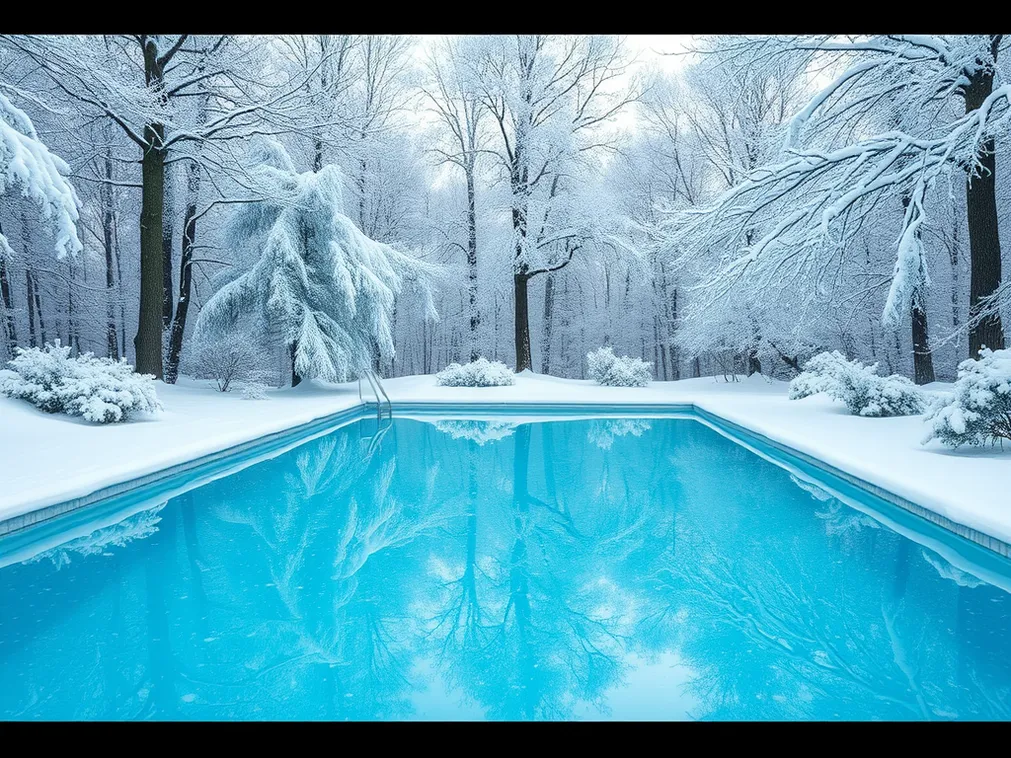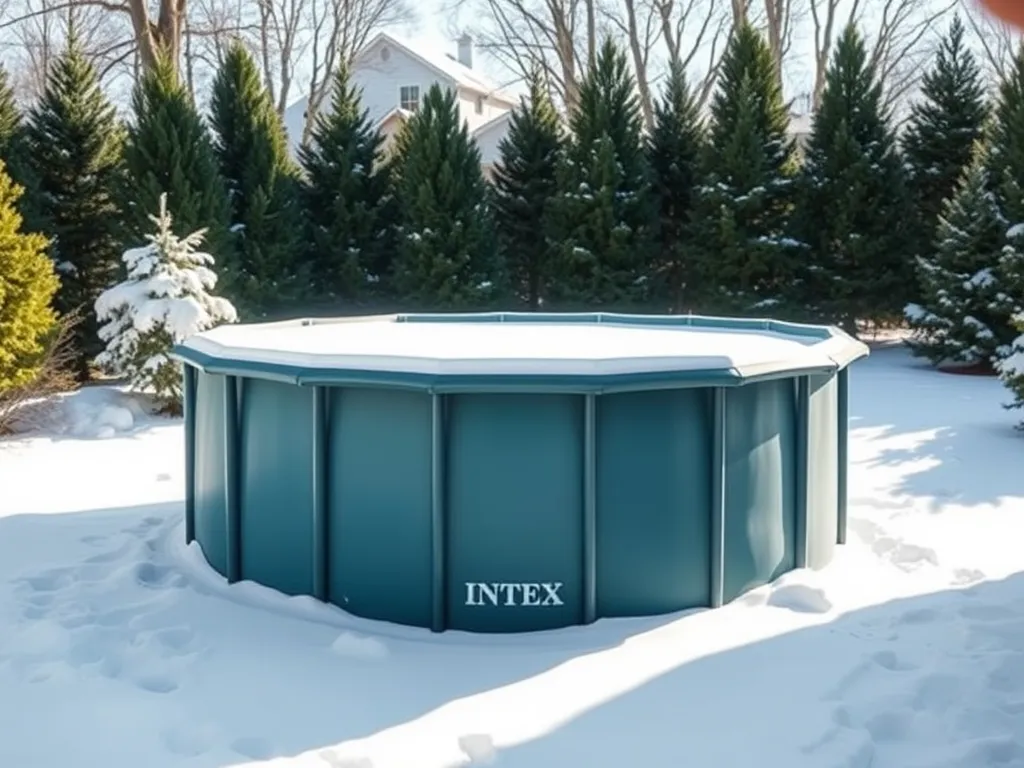How to Close an Inground Pool: Step-by-step Guide
Published on: November 22, 2025 | Last Updated: November 17, 2025
Written By: Marcus Thornfield
Closing an inground pool means preparing it for winter by balancing water chemistry, lowering the water level, protecting equipment from freezing, and sealing it with a durable cover. Unlike temporary covers used for above-ground pools, inground winterization requires specific steps to prevent liner damage, plumbing cracks, and algae growth during colder months. Proper closing prevents costly repairs and keeps your pool ready for spring reopening.
This guide breaks down the exact process for winterizing inground pools, from basic chemical treatments to handling complex equipment like sand filters or automatic safety covers. You’ll learn how to choose the right algaecides and shock treatments, calculate antifreeze needs for plumbing lines, and avoid common mistakes like improper water level adjustments. We’ll also cover how freezing temperatures impact saltwater systems and heated pools.
Whether you’re tackling a DIY close or hiring a pro, we’ve included cost comparisons, tips for vinyl liner care, and solutions for extreme weather scenarios. Discover why leaving just 6 inches of water below the skimmer can prevent tile damage, how winterizing kits save up to $300 versus buying chemicals separately, and which cover types last 10+ seasons. Get ready to protect your investment with precision.
Essential Steps to Close an Inground Pool
Properly shutting down your pool prevents freeze damage, maintains water quality, and protects equipment. Follow these steps to ensure your inground swimming pool survives winter without issues. As you prepare for the colder months, it’s also important to consider the care of your hot tub. Using a shock treatment for your hot tub can help keep the water clean and balanced, ensuring a pleasant experience when you’re ready to use it again.
Crucial Winterizing Products
"The all-in-one solution for a guaranteed clear spring opening."
All-in-One Closing Chemical Kit
Winter demand is high - check stock
"The 'set & forget' option. This is the easiest winterizing I've ever done."
Simple 3-in-1 Winterizing Balls
Winter demand is high - check stock
"Invest once to protect your liner and prevent a swamp in the spring."
Heavy-Duty Winter Pool Cover
Winter demand is high - check stock
Preparing the Pool for Winterization
Start by removing debris using nets or robotic cleaners. Brush walls thoroughly to eliminate biofilm buildup. Vacuum sediment from the floor to prevent staining. For vinyl-lined pools, inspect seams for tears needing repair before temperatures drop below 50°F. Clear skimmer baskets, pump strainers, and pool sweeps to ensure unrestricted water flow during final chemical treatments. Keeping your pool in top shape also means paying attention to the clean pool floaties. Clean pool floaties help keep the water fresh and enjoyable for everyone.
Balancing Water Chemistry Before Closing
Test pH (7.2-7.6), total alkalinity (80-120 ppm), and calcium hardness (175-225 ppm). Adjust using sodium bisulfate or baking soda if needed. Sanitizer levels should sit between 1-3 ppm chlorine or 3-5 ppm bromine. Add winterizing chemicals: polyquat 60 algaecide (12-18 oz per 10k gallons) prevents microbial growth, while oxidizing shock (1 lb per 10k gallons) destroys contaminants. Stabilized chlorine tabs in floating dispensers provide residual protection.
Lowering Water Level Safely
Drain water 4-6 inches below the tile line or skimmer mouth, whichever is lower. Use submersible pumps for precise control. Vinyl-lined pools require maintaining at least 12 inches of water to prevent liner shrinkage. For solid safety covers, keep levels 18 inches below coping to avoid sagging. Plug return jets with threaded winterizing plugs, and insert skimmer guards to protect against ice expansion. When it comes to inflatable pools, proper draining is just as important. Draining the pool completely helps to prevent mold and damage during the off-season.
Winterizing Pool Equipment and Plumbing
Drain pumps, filters, heaters, and chlorinators completely. Blow out plumbing lines using 25-50 PSI compressed air until bubbles rise in the pool. Seal lines with rubber expansion plugs or threaded caps. Pour RV-grade antifreeze (non-toxic propylene glycol) into skimmer lines, drains, and pump baskets—typically 2-3 gallons per line. Store removable equipment like ladders or diving boards in dry areas to prevent corrosion.
Installing a Winter Pool Cover
Choose covers based on climate: mesh allows rain drainage but blocks sunlight, while solid vinyl stops debris but requires pumps for puddling. Secure edges with water tubes (filled ⅔ full) or spiral anchors spaced 2-3 feet apart. For safety covers, tension springs should flex 50-75% of their length when hooked. Leave slack for snow load—covers stretched too tightly risk tearing under ice weight.
With your cover secured, the next phase focuses on adapting these steps to unique pool setups—from vinyl liners to saltwater systems. Let’s explore specialized methods for different designs.
How to Close Specific Pool Types and Features
Closing an Inground Pool With a Vinyl Liner
Vinyl-lined pools require extra care during inground pool closing to prevent liner damage. Lower water 12-18 inches below the skimmer – never drain completely, as this risks liner shrinkage or tears. Brush walls to remove debris, then add a vinyl-safe algaecide. Install air pillows under the cover to absorb ice pressure. Secure the cover tightly with water tubes or sandbags, avoiding direct contact between the liner and cover material. Proper maintenance is key to keeping your pool in good shape. Ensuring a clean pool floor helps prevent algae growth and makes swimming more enjoyable.
Winterizing an Inground Pool With a Sand Filter
For sand filter systems, start by backwashing thoroughly until the pressure gauge reads 10 PSI. Remove the drain plug and store it with the pump. Blow out plumbing lines with a cyclone blower or air compressor, then plug returns. Leave the multiport valve on “Winterize” or remove it entirely if temperatures drop below freezing. Never leave water in the filter tank – sand can freeze and crack the housing. When you know how to winterize your system, you can also see how it connects to the pool filter diagram. The diagram shows how all parts work together, helping you visualize the filtration process.
Closing Pools With Automatic Safety Covers
Automatic safety covers simplify inground pool winterization but demand specific prep. Lubricate cover tracks with silicone spray and test the motor’s limit switches. Remove debris from the cover box with a wet/dry vacuum. Keep water level 3-4 inches below the coping to prevent cover submersion. Use foam cover seals on track openings to block ice formation. Always engage the manual override key for emergency access. Taking care of your pool cover can also help maintain the temperature of your water. Keeping your above ground pool cool is essential for a pleasant swim during hot days.
Winterizing Heated Inground Pools
Gas and heat pump systems need specialized shutdown steps. For gas heaters, turn off the gas supply valve and drain the heat exchanger using the drain cock. Electric heat pumps require removing the drain plugs and blowing out residual water. Install winterizing plugs in all heater connections. Solar heating systems demand full drainage – use compressed air at 15 PSI to clear panels and pipes. Bypass valves must be set to “Closed” position.
Closing Without Draining Water
Water preservation methods work best in mild climates (zones 7-10). Balance pH to 7.2-7.6 and raise chlorine to 5-10 ppm before adding winterizing chemicals. Use submersible pumps to circulate water monthly if temperatures stay above 40°F. Solid safety covers with permeable mesh centers prevent debris buildup while allowing rainwater drainage. This method reduces spring startup costs by up to 35% compared to full drainage.

Pool Closing Chemicals and Supplies
Winterizing Chemical Kits Explained
Professional-grade closing kits contain four key components: shock (calcium hypochlorite at 65%), stain preventer (HEDP-based sequestering agents), algaecide (polyquat 60%), and pH balancers. For 20,000-gallon pools, use 2 lbs shock + 32 oz algaecide + 16 oz stain control. These concentrated formulas maintain water clarity for 6-8 months and reduce spring algae blooms by 90% compared to basic chlorine-only treatments. Choosing the right algaecide is essential for keeping your pool clean and preventing algae growth. This best pool algaecide options available on the market will help you explore the best pool algaecide options available on the market.
Algaecides and Shock Treatments
Non-foaming algaecides work best for inground pool winterization – look for benzalkonium chloride at 50% concentration. Shock with calcium hypochlorite (68%) 24 hours before closing to reach 30 ppm chlorine levels. Avoid stabilized chlorine (trichlor) which can bleach liners. For saltwater pools, supplement with sodium bromide to prevent white mold. Always test free chlorine after 12 hours – levels below 5 ppm require re-treatment. Maintaining a clean environment is crucial for pool health. An algaecide saltwater pool makes this easier while keeping algae at bay.
Antifreeze for Pool Plumbing
Use only RV/marine-grade propylene glycol antifreeze (60% concentration) in plumbing lines. Each return jet needs 1-2 gallons depending on pipe length. Pour slowly through the skimmer until antifreeze emerges at returns. Never use automotive ethylene glycol – it’s toxic and damages O-rings. For extreme climates (-20°F or lower), combine antifreeze with air blowouts for triple freeze protection.
Choosing the Right Winter Cover
Mesh covers (8×8 weave) suit rainy climates, draining 95% of precipitation while blocking debris. Solid vinyl (18-22 oz) works best in snowy regions – use cable winches with 1,500 lb tensile strength for secure anchoring. Safety covers require 12” overlaps and 6” concrete anchors for inground pools. Premium covers last 8-12 years versus 3-5 for economy models. Look for ASTM F1346-91 certification on all safety-rated products. In addition to covers, pool pillows serve an important role. They help prevent water accumulation and protect the pool’s structure during winter.
Proper winterization sets the stage for cost management. Next, we’ll break down pricing factors for DIY versus professional inground pool closing services.
Also See: Can You Swim in Pool in Dominican Republic December?
Cost Considerations for Pool Closing
Shut down costs change based on your method. Know your options before picking a plan.
DIY Vs Professional Closing Costs
Do-it-yourself shut downs run $75-$300 for chemicals, plugs, and gear. Pros charge $150-$500+ based on pool size and gear. Full-service plans may add $50-$150 for covers or gear storage. Weigh time vs cash – a 20×40 pool takes 6-8 hours for new owners to winterize solo. Considering the cost of maintenance is important when looking at the overall investment. A small inground pool can vary greatly in price, and understanding these costs helps in making a smart decision.
Factors Affecting Service Pricing
- Pool size (under 12k gal vs over 30k gal)
- Cover type (mesh $120-$400, solid $300-$800)
- Extra steps for water features or heaters
- Local labor rates ($45-$75/hr avg)
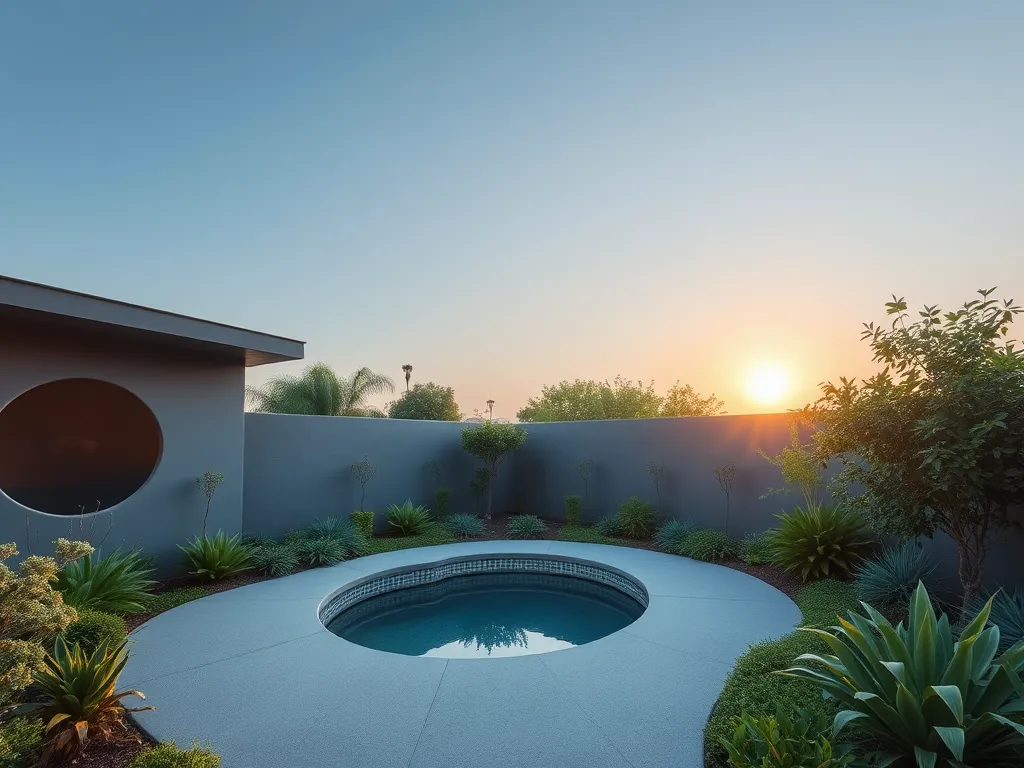
Critical Mistakes to Avoid When Closing
Skip these errors to save cash and spring start-up stress.
Improper Water Level Adjustment
Drop water 4-6 inches below skimmer for tile pools. Vinyl liners need 12-18 inches down to avoid ice tears. Too low risks liner shift in wet soil.
Neglecting Equipment Winterization
Blow out lines with 25-50 PSI air. Add pool-safe RV antifreeze (pink, not car type) to pumps and pipes. Store filters dry to stop mold.
Incorrect Chemical Dosages
Aim for pH 7.2-7.6, alkalinity 80-120 ppm, 30-50 ppm chlorine. Shock with 2 lbs per 10k gal. Use 6-12 oz algaecide based on brand specs. Test strips help check levels pre-cover. Proper pool maintenance ensures a clean and inviting swimming environment. Harrah’s New Orleans pool is a popular spot for relaxation and fun.
Failing to Secure the Cover Properly
Use 40-60 water bags (or 100+ lbs of weights) for solid covers. Mesh needs 2-inch gaps between cable anchors. Check straps every 4 weeks for snow load sag.
Special Scenarios for Pool Closing
Some pools need extra steps for safe winter months.
Closing Pools in Freeze-prone Areas
Add freeze plugs to skimmers. Use air pillows under covers in zones with temps below 20°F. Insulate pipes with foam wrap where ground freezes past 12 inches.
Preparing for Severe Weather Events
Take down umbrellas, loose gear. Switch off power at the main. For hurricane zones, use 2+ layers of cover clips. Clear drains near pool decks to stop flood damage.
Winterizing Saltwater Pools
Unplug salt cells and store dry. Test chlorinator plates for wear. Balance cyanuric acid to 30-50 ppm. Check metal parts (ladders, lights) for rust due to salt air.
With your pool prepped for cold months, let’s tackle common questions owners face during shut down.

FAQs About Closing Inground Pools
How Early Should I Begin the Pool Closing Process?
Start closing 1-2 weeks before your area’s first frost date. This allows time for chemical balancing, equipment maintenance, and addressing unexpected issues. Ideal water temperatures are 50-60°F—cold enough to inhibit algae but warm enough for safe chemical mixing.
Can Automotive Antifreeze Damage Pool Plumbing?
Yes. Automotive antifreeze contains ethylene glycol, which is toxic and corrodes O-rings. Always use RV/marine-grade propylene glycol antifreeze (pink-colored) specifically formulated for potable water systems. It remains non-toxic at dilutions up to 50%.
How Should Pools With Attached Spas Be Winterized?
Isolate the spa with shut-off valves, drain both bodies separately, and blow out shared plumbing lines. For spillover systems, install freeze plugs in the waterfall channel. Heaters require bypassing and draining—spa jets often need individual air blowing to clear trapped water.
What Deters Animals From Nesting Under Covers?
Install taut cable locks around the cover perimeter and use ultrasonic rodent repellents near equipment pads. Place mothballs in mesh bags (not directly on covers) along edges. Trim nearby vegetation to eliminate shelter and check for gaps weekly during early winter.
Are Eco-friendly Winterizing Chemicals Effective?
Enzyme-based treatments (like phosphate removers) and oxygen shock can reduce chemical usage by 40%. Look for NSF/ANSI 50-certified products. However, in freeze-prone zones, traditional algaecides remain essential—combine them with enzyme boosters for greener results.
What if Ice Forms Despite Winterization?
Never break ice mechanically. Use floating de-icers (1,500W for 14×28 pools) to melt a central opening. Add calcium chloride pellets (2 lbs per 10k gallons) to lower water’s freezing point. Check plumbing lines immediately for cracks once temperatures rise above 50°F. It’s also important to protect your copper pool plumbing from corrosion during the cold months. Regular maintenance and proper water balance can help extend the life of your plumbing system.
Must Filters Be Cleaned Before Storage?
Cartridge filters require soaking in TSP solution and hosing. DE grids need backwashing plus a muriatic acid soak (10:1 water ratio). Sand filters should be backwashed until clear and treated with filter cleaner—stored dry. Dirty filters invite bacterial growth and reduce spring efficiency by 30%.
Closing Thoughts
Properly closing your inground pool protects your investment through winter. Following each step – from balancing chemicals to securing the cover – prevents costly spring repairs. Freeze damage, algae blooms, and equipment failures become far less likely with careful winterization.
Remember these key points: test water chemistry 3-5 days before closing, lower water levels 4-6 inches below skimmers, and use pool antifreeze in plumbing lines. Vinyl liner pools need special care to avoid stretching, while saltwater systems require extra flushing.
For precise chemical calculations or equipment specs, try our My Pool Calculator tools. You’ll find exact dosing recommendations based on your pool’s size and type.
Whether tackling this as a DIY project or hiring professionals, use this guide as your winterization roadmap. A few hours of proper closing now saves days of cleanup when warmer weather returns.
Additional Resources for You:
- Pool & Hot Tub Alliance (PHTA). (2021). ANSI/APSP/ICC-11 Standard for Water Quality in Public Pools and Spas. Alexandria, VA: PHTA.
- How to Winterize a Pool in 9 Steps (Inground & Above Ground)
- Pool Closing: How to Winterize a Pool | ARM & HAMMER™
- How to Close Inground Pools
- How to Winterize a Pool | Latham Pool

